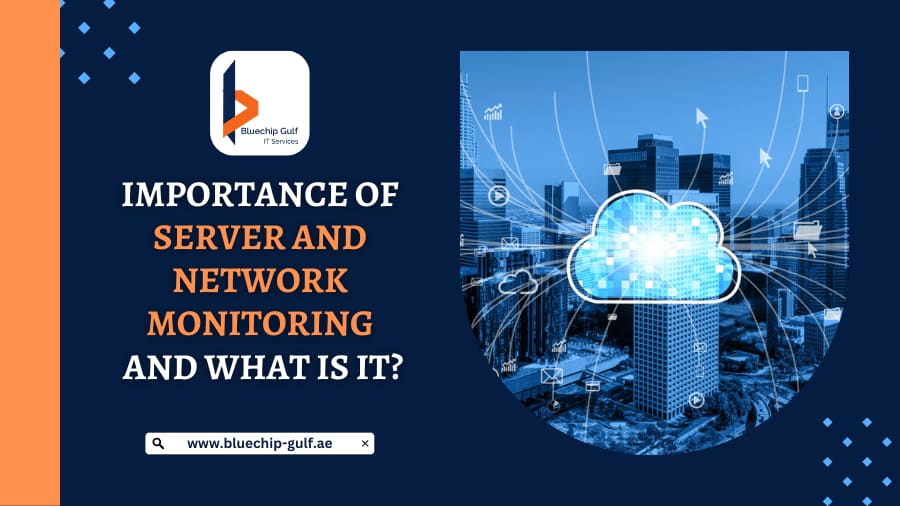
In today’s technology-driven world, businesses heavily rely on servers and networks to facilitate seamless communication, data storage, and application delivery. However, without proper monitoring, these critical IT infrastructure components can experience issues that lead to downtime, performance degradation, and potential security vulnerabilities. In this blog post, we will explore the importance of server and network monitoring, highlighting its role in enhancing performance, ensuring reliability, and mitigating potential risks.
What is Server and Network Monitoring?
Server and network monitoring refers to the practice of actively tracking and observing the performance, availability, and security of servers and network devices within an IT infrastructure. It involves using specialized tools and software to collect real-time data on various aspects of the servers and network components, such as resource utilization, response times, network traffic, and security events.
Server monitoring concentrates on observing the implementation and health of individual servers or virtual machines. It involves tracking parameters like CPU usage, memory utilization, disk space, application response times, and server availability. Monitoring server metrics helps identify performance bottlenecks, capacity issues, or potential hardware/software failures, enabling proactive troubleshooting and optimization.
Network monitoring, on the other hand, revolves around monitoring network devices, including routers, switches, firewalls, and network links. It involves monitoring network traffic, bandwidth utilization, latency, packet loss, and device availability. Network monitoring helps identify network congestion, network performance issues, security breaches, or configuration errors, facilitating prompt resolution and ensuring efficient network operation.
How Does Server and Network Monitoring Work?
Server and network monitoring works by employing specialized tools and software that continuously track and analyze various metrics related to the performance, availability, and security of servers and network devices.
1. Data Collection
Monitoring tools gather data from servers and network devices in real-time. This data includes information on server performance metrics such as CPU usage, memory utilization, disk space, network traffic, response times, and error logs.
Network monitoring tools capture network traffic data, including bandwidth utilization, latency, packet loss, and device availability. This data is collected either through agents installed on the monitored devices or by leveraging protocols such as SNMP (Simple Network Management Protocol) for network devices.
2. Data Storage and Analysis
The collected data is kept in a centralized database or monitoring platform. The monitoring software analyzes the data, applying predefined rules and thresholds to determine the status and health of the servers and network components. The analysis includes identifying performance bottlenecks, resource constraints, anomalies, or potential security incidents.
Advanced monitoring tools may employ machine learning or artificial intelligence algorithms to detect patterns and anomalies for more accurate analysis and alerting.
3. Alerting and Notification
When deviations from normal behavior or predefined thresholds are detected, the monitoring system triggers alerts and notifications. These alerts can be sent via email, SMS, or other communication channels to the designated administrators or IT teams.
Alerts provide real-time information about the issue, including details on the affected server or network component, the nature of the problem, and its severity. Administrators can set up different alerting levels relying on the quickness and effect of the problems detected.
4. Visualization and Reporting
Monitoring tools often provide intuitive dashboards and visual representations of the collected data. These visualizations allow administrators to have a holistic view of server and network performance, trends, and any issues that require attention.
Monitoring platforms also generate detailed reports, summarizing historical performance data, alert trends, and compliance information. These reports help administrators in capacity planning, troubleshooting, performance analysis, and meeting compliance requirements.
5. Remediation and Troubleshooting
Once an issue is identified through monitoring, administrators can take suitable measures to determine it. This may involve investigating the root cause, making necessary configuration changes, allocating additional resources, or engaging in troubleshooting steps.
Monitoring tools can provide insights and data to assist in the remediation process, helping administrators track the progress of issue resolution and verifying the effectiveness of implemented solutions.
6. Performance Optimization and Planning
By analyzing the collected data over time, administrators can identify trends, patterns, and areas for optimization. This includes optimizing server configurations, fine-tuning network settings, planning for capacity upgrades, or implementing performance-tuning measures.
Monitoring data helps in making data-driven decisions to ensure optimal performance, scalability, and resource utilization.
Understand the Importance of Server and Network Monitoring
1. Proactive Issue Detection and Resolution
Server and network monitoring enables proactive identification and resolution of issues before they impact business operations. By constantly observing server implementation metrics, such as CPU utilization, memory usage, and disk space, administrators can detect potential bottlenecks, resource constraints, or impending hardware failures.
Similarly, network monitoring allows for real-time visibility into network traffic, latency, and packet loss, helping identify network congestion, connectivity issues, or security threats. Proactive monitoring enables prompt troubleshooting and resolution, reducing downtime and minimizing the impact on business productivity.
2. Performance Optimization
Server and network monitoring provides valuable insights into the commission of IT infrastructure elements. By analyzing data on resource utilization, response times, and application performance, administrators can identify areas for optimization. This includes optimizing server configurations, adjusting resource allocation, fine-tuning network settings, and upgrading hardware or software when necessary.
Continuous monitoring helps organizations maximize the efficiency and responsiveness of their systems, resulting in improved user experiences, faster application delivery, and enhanced overall performance.
3. Ensuring High Availability
Server and network downtime can have significant consequences, leading to financial losses, decreased productivity, and damage to reputation. Monitoring plays a crucial role in ensuring high availability and minimizing unplanned service disruptions.
By setting up alerts and notifications based on predefined thresholds, administrators can be promptly notified of any deviations from normal operation. This allows them to take immediate action, investigate the cause, and resolve the issue before it escalates, thus minimizing downtime and maximizing system uptime.
4. Security Threat Detection and Mitigation
The ever-present risk of security breaches and cyber threats necessitates robust monitoring practices. Server and network monitoring tools capture and analyze security-related events, such as unauthorized entry attempts, unusual network traffic patterns, or system vulnerabilities. This enables timely detection of security incidents, allowing administrators to respond swiftly, initiate countermeasures, and mitigate potential risks.
Monitoring can also help identify configuration weaknesses, update patch levels, and ensure compliance with security best practices, strengthening the overall security posture of the IT infrastructure.
5. Capacity Planning and Scalability
Effective server and network monitoring provide valuable insights into resource utilization trends and capacity requirements. By examining historical data and forecasting future needs, administrators can plan for resource scalability and optimize capacity. This allows organizations to avoid overprovisioning or underutilization, consequently in cost savings and enhanced resource distribution.
Monitoring helps identify potential capacity constraints and allows for proactive measures to accommodate growth, ensuring a scalable and agile IT infrastructure.
6. Compliance and Auditing
In many industries, organizations must adhere to regulatory and compliance requirements. Server and network monitoring assist in meeting these obligations by capturing and logging relevant data. This includes system events, user activities, security incidents, and access logs.
Monitoring tools generate comprehensive reports and audits that demonstrate compliance with industry standards and provide evidence for regulatory inspections. This helps organizations ensure accountability, maintain data integrity, and meet legal and compliance obligations.
Also Read: Network and Server Migration

